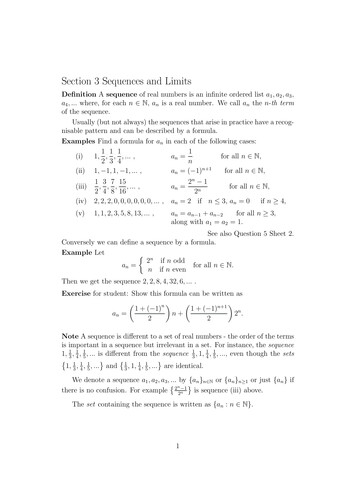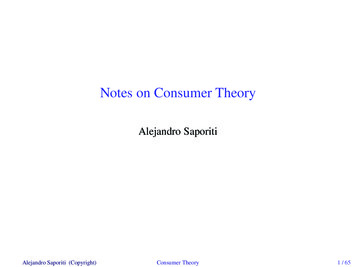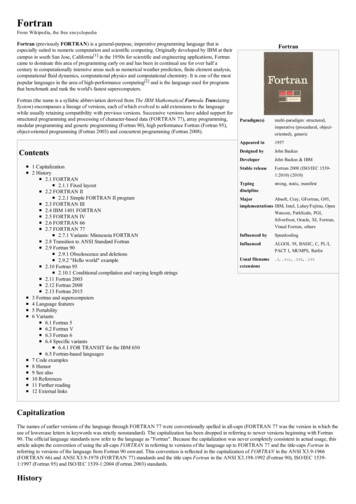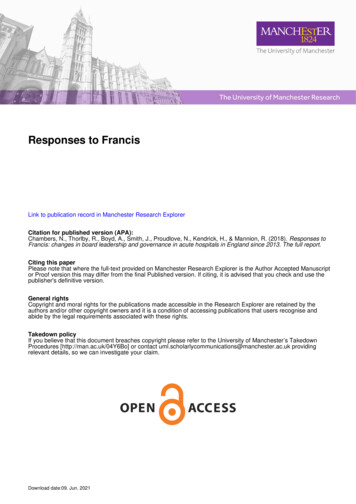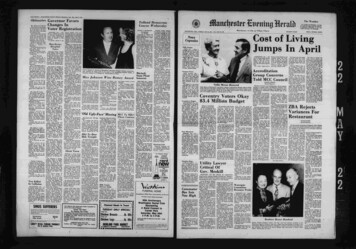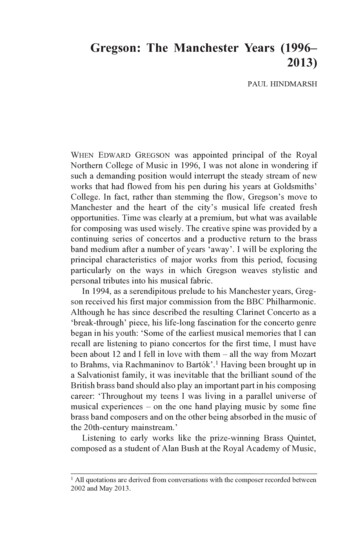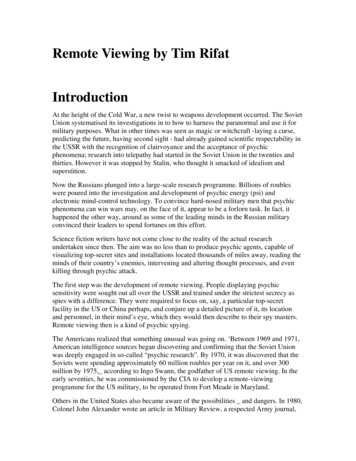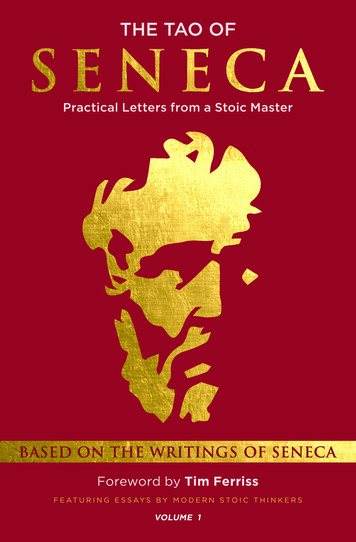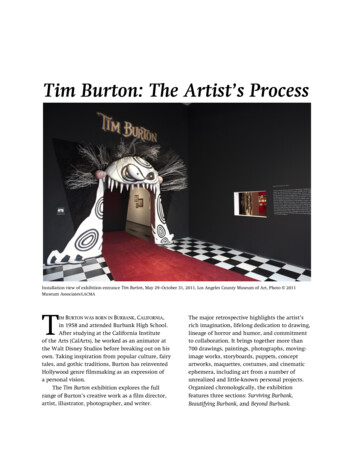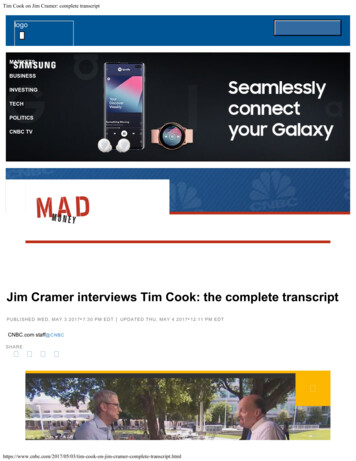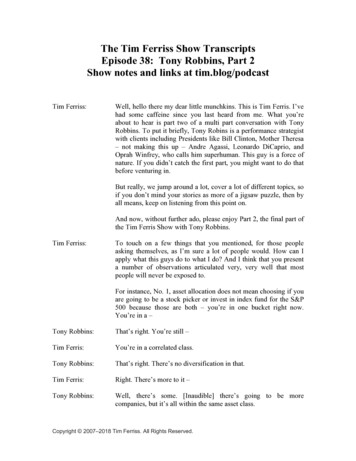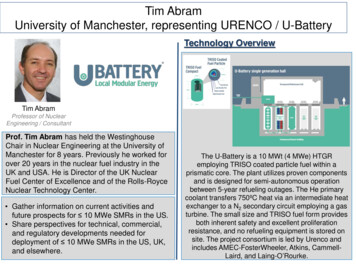
Transcription
Tim AbramUniversity of Manchester, representing URENCO / U-BatteryTechnology OverviewTim AbramProfessor of NuclearEngineering / ConsultantProf. Tim Abram has held the WestinghouseChair in Nuclear Engineering at the University ofManchester for 8 years. Previously he worked forover 20 years in the nuclear fuel industry in theUK and USA. He is Director of the UK NuclearFuel Center of Excellence and of the Rolls-RoyceNuclear Technology Center. Gather information on current activities andfuture prospects for 10 MWe SMRs in the US. Share perspectives for technical, commercial,and regulatory developments needed fordeployment of 10 MWe SMRs in the US, UK,and elsewhere.The U-Battery is a 10 MWt (4 MWe) HTGRemploying TRISO coated particle fuel within aprismatic core. The plant utilizes proven componentsand is designed for semi-autonomous operationbetween 5-year refueling outages. The He primarycoolant transfers 750ºC heat via an intermediate heatexchanger to a N2 secondary circuit employing a gasturbine. The small size and TRISO fuel form providesboth inherent safety and excellent proliferationresistance, and no refueling equipment is stored onsite. The project consortium is led by Urenco andincludes AMEC-FosterWheeler, Atkins, CammellLaird, and Laing-O’Rourke.
Todd AllenIdaho National Lab / Third WayTechnology OverviewHeadshot Senior Fellow at Third Way Deputy Director for S&T at INL Professor University of Wisconsin Argonne National Laboratory-West U.S. Navy Nuclear Power Program. Understanding range of options to which nuclearcan support Identify policy and technical (material science)needsOptional: Describe your technology relevant to thisworkshop in a few bullets and add a summarygraphic if possible.
Yasir ArafatWestinghouse Electric Company LLCTechnology OverviewWhy should Nuclear playas a Decentralized Generator(DG) ?Yasir ArafatSenior Innovation EngineerYasir Arafat is currently an Innovation Project lead atWestinghouse R&D. He has 6 years nuclear industryexperience in innovation and systems design of nuclearreactors such as Westinghouse SMR and AP1000. Hesubmitted 13 patent disclosures, of which 4 were filed.His areas of expertise lies in nuclear systems & productdesign, development and qualification testing to driveinnovation products from concept to market Contribute information to ARPA-E to inform a potentialnew ARPA-E program on nuclear fission energy Guide the attributes of the Micro Reactor that can leadto the integration of nuclear in the modernized grid.Discuss technology, market, & licensing challenges Socioeconomic Drivers for DG:resilient, reliable, efficient, costeffective, flexible and sustainableenergy supply Government Policies plays ainfluential role in the shift to DG Utilities are investing capital inefficiency / demand reductionefforts, and T&D to integraterenewables and DG Nuclear currently does not playin DG market, which makes it apotential opportunity inaccordance with Westinghouse’s“Right to Grow” strategy
Stephen Bell, Naval ReactorsTechnology OverviewDirector of OHIO Replacement submarinereactor design. 27 years delivering andmaintaining new reactors and reactortechnologies for US Navy ships andNASA Project Prometheus.Review compact reactor concepts andprovide perspective on challenges andconstraints for small nuclear power plants.Naval Reactors is a joint Departmentof Navy/Department of Energyorganization responsible for R&D,design, delivery, and disposal ofnuclear propulsion plants for ships.
Shannon Bragg-SittonIdaho National LaboratoryTechnology OverviewConc.WindSolarLight WaterSMRElectricalEnergyThermalStorage Share previous experience in the design,analysis, and nonnuclear testing of ultra-smallfission systems for space nuclear power andpropulsion and terrestrial applications Define the use case for and explore thepotential of MW-class fission reactors forterrestrial eTempProcessesElectricityBatteryLow Carbon Electrical Power GridPowerGenerationThermalEnergyDr. Shannon Bragg-Sitton currently serves asthe Deputy National Technical Director for theDOE-NE Advanced Fuels Campaign. She alsoleads R&D for novel Nuclear-RenewableHybrid Energy Systems under the DOE-NECrosscutting Technologies Program.PV SolarNaturalGasHighTempProcessesLow Carbon Products: Fuel, Chemicals, Metals, Water, etc.Hybrid energy systems that seek to optimize theuse of low-carbon energy sources to meet gridelectricity and industrial energy needs are beinginvestigated for small modular reactors. Thisconcept can be translated to microreactorsinstalled in remote regions to ensure that energysources are used efficiently and electrical andthermal energy needs are met reliably.
Jacopo BuongiornoMassachusetts Institute of Technology (MIT)EducationPolytechnic of MilanNuclear EngineeringB.S.Massachusetts Institute of Technology Nuclear EngineeringPh.D.19962000Professional Experience2015Associate Department Head, Nuclear Science and Engineering, MIT2015Director, Center for Advanced Nuclear Energy Systems (CANES)2015Professor of Nuclear Science and Engineering, MIT2011Accreditation Board - National Academy of Nuclear Training (NANT)2011-2012 Special Committee on Fukushima, American Nuclear Society2008-2015 Associate Professor of Nuclear Science and Engineering, MIT2004-2008 Assistant Professor of Nuclear Science and Engineering, MIT2000-2004 Research Scientist, Idaho National LaboratoryAwards and Honors Ruth and Joel Spira Award for Distinguished Teaching, School of Engineering, 2015, 2011 and 2006. MacVicar Award for Excellence in Undergraduate Teaching, MIT, 2014. Best Paper Award at the 9th Int. Topical Meeting on Nucl. Thermal-Hydraulics, Operation and Safety (NUTHOS-9),Kaohsiung, Taiwan, September 9-13, 2012. 2 most cited articles in Int J Heat Mass Transfer 2007-2012. Landis Young Member Engineering Achievement Award, American Nuclear Society, 2011. ASME Heat Transfer Division Best Paper, 2008. Best Paper Award at the 1st Micro/Nanoscale Heat Transfer Int. Conf., Tainan, Taiwan, January 6-9, 2008 Junior Bose Award for Excellence in Teaching, MIT School of Engineering, November 2007 Carl R. Soderberg Professor of Power Engineering Chair, MIT, July 2007-to present Graduate Teaching Award, MIT School of Engineering, 2005 Norman C. Rasmussen Career Development Chair in Nuclear Engineering, MIT, 2004-2006 Mark Mills Award for Best Nuclear Engineering Doctoral Thesis in the U.S., American Nuclear Society, 2001Publications76 journal articles, 150 conference paper, 4 patents
Alice CaponitiDOE, Office of Nuclear EnergyTechnology OverviewMs. Caponiti is currently serving as the Director forSpace and Defense Power Systems in the Office ofNuclear Energy’s Office of Advanced ReactorTechnologies. She also serves on the Experts Groupfor the Generation IV International Forum, acooperative R&D framework to establish feasibilityand performance capabilities of next generationnuclear systems. Understanding the potential for mega-watt sizednuclear power as an additional option for electricitygeneration and broader energy production. The mission of the Department of Energy, Officeof Nuclear Energy (DOE-NE) is to advancenuclear power as a resource capable of meetingthe Nation's energy, environmental and nationalsecurity needs by resolving technical, cost,safety, proliferation resistance, and securitybarriers through research, development anddemonstration ﴾RD&D﴿. The mission of the Office of Space and DefensePower Systems is to provide nuclear powersystems for space exploration and nationalsecurity applications, through design,development, fabrication, testing and delivery,and to conduct safety assessments to supporttheir use.
Sacit M. CetinerOak Ridge National Laboratory (ORNL)Technology OverviewSacit M. ReactorR&D StaffDr. Sacit M. Cetiner is an R&D Staff memberin Advanced Reactor Systems and Safety atORNL. His primary research focus is modelingand simulation of nuclear power systems,large-scale complex system optimization, andautonomous decision-making methods. Understand the mission and objectives of apotential ARPA-E program on fission energysystems Introduce recent design activities on smallmodular advanced reactors at ORNLThe Oak Ridge National Laboratory staff haveinvented and demonstrated multiple nuclear reactorclasses. Recent areas of emphasis include bothcommercial and research reactors, as well asspecial-purpose reactors—such as space power andhomogeneous reactors for medical isotopes.ORNL has extensive experience in conductingtechnology gap analyses for new designs to developtechnology development roadmaps and performingviability assessments to support down selection ofreactor concepts.
Dasari V. (“DV”) RaoLos Alamos National LaboratoryDV Rao is LANL Program Director for CivilianNuclear Programs. He is also conductingresearch into nuclear fuels and nuclear testingrequirements for micro- and advanced reactors Understand ARPA-E needs for nuclearprototyping and testing Understand potential for collaboration with otherdesigners and developers.High-FidelityNuclear Tests -CriticalsKineticsRossi-AlphaFeed-Back
Leslie Dewan, Ph.D.Transatomic PowerTechnology OverviewHeadshotLeslie is the CEO of Transatomic Power. Shereceived her Ph.D. in nuclear engineering fromMIT, with a research focus on computationalnuclear materials. She is a member of the MITCorporation, MIT’s board of trustees. She is aTIME Magazine "30 Under 30" and a WorldEconomic Forum Young Global Leader. Domestic and international market scope forMW-scale nuclear reactorsUS regulatory and commercializationpathway for advanced small reactorsFull-scale commercial product is a 520 MWemolten salt reactor consuming both spentnuclear fuel and low-enriched fresh uraniumfuel. The design enables the following features: Walk-away safetyHigh burnup and reduced wasteCentralized, modular manufactureCost-competitive with fossil fuelsInvestigating possibility ofsmall-scale first commercialproduct – container-sized10 MWe molten saltreactor consumingfresh uranium fuel.
Robert (Bob) FerenczLawrence Livermore National LaboratoryTechnology OverviewParticipating in DOE’s NEAMS program as a partnerto Argonne National Laboratory teamin constructing a multi-physics simulation systemDr. Robert Ferencz currently serves as theDivision Leader for Computational Engineeringat LLNL. He has 30 years experience in codedevelopment for modeling & simulation in solid/structural mechanics and multi-physics. Get an overview of the technological opportunitiesand regulatory challenges to fielding a portable 10MW reactor system Explore opportunities for advanced modeling &simulations to help identify design solutions atmultiple scalesSHARP Reactor SimulatorSHARP BrochurePROTEUSNeutronicsSIGMA echanics
Claudio Filippone, Ph.D.Filippone & Associates LLCTechnology OverviewClaudio FilipponePresidentDr. Filippone is an expert in nuclearengineering and power producing systems withdecades of problem solving experience. Hehas authored several patents on energyproducing and conditioning systems andworked on light-water and advanced nuclear,fossil fueled, and renewable energy powerplants since 1996. Author of specialized technical-economic reports onLWRs and SMRs, and designed hardened smallmodular reactors for military applications. Assisting ARPA-E to explore the potential of makingsafe & secure 10-MW size nuclear reactors infactories, certifying (once only) in factories, andtransporting to user sites without recertification. Air-cooled 10% enriched, melt-tolerant fuel,“Holos”: 10MWe reactor formed by integralcomponents enabling factory assembly,testing as a whole system, and certification. 10 years autonomy, deployable viaconventional transportation platforms, fullyintegrated and shielded within ISO containers.DistributablePower Sources
Massimiliano (Max) FratoniUniversity of California, Berkeley (UCB)Technology OverviewMax FratoniAssistant ProfessorDr. Max Fratoni is currently assistantprofessor at UCB. Previously, he worked at theLawrence Livermore National Laboratory andPennState. His research focus is on advancedreactor design and analysis for improvedresource utilization and waste minimization. Gather information on a potential new ARPA-Eprogram on nuclear fission energy. Explore how our neutronics and multi-physicsmodeling capabilities could help in designingsafe & secure 10-MW size nuclear reactors.Experience with numerous advanced reactortechnologies:- Molten Salt Reactors, both solid and liquid fuels- Sodium-cooled fast reactors- Lead-cooled fast reactors- Battery type reactors (ENHS)- Reduced Moderation BWR- and moreState-of-the-art and unique modeling tools:- Uncertainty quantification based on Monte CarloGPT and XGPT- Coupled Monte Carlo–OpenFOAM for multiphysics modelingCoupled SerpentOpenFOAM simulationof a control rod insertionin a Pebble BedFlouride-cooled Hightempreature Reactor
E. Travis GitauPacific Northwest National Laboratory (PNNL)Technology OverviewDesignModificationsFacility ialSafeguardsIssuesFSA ToolkitReference DesignSafeguardsApproachModificationsE. Travis Gitau is a international safeguardsanalyst and nuclear engineer at PNNL. For thelast 5 years at PNNL his research has focusedin safeguards implementation for emergingSMR designs and the impact of the fuel cycleon nonproliferation policy.--Gain a greater understanding of designerefforts to incorporate nonproliferation andsafeguards considerations as part of designeffortsExplore the safeguards challenges that themanufacture, operation, and decommissioningof 10 MW nuclear plants presentReferenceFacility SafeguardsApproachNegotiation Basis forSafeguards ApproachThe Facility Safeguards Assessment (FSA) process(graphically represented above) was developed toprovide facility designers and safeguards SMEs ameans to identify potential safeguards challengesthat new and emerging nuclear facility designs mayraise. This process represents one tool/resource thatthe international safeguards community hasdeveloped to inform and engage designers andcountries on “safeguards by design”.PNNL-SA-116541
Chris J. HamiltonUltra Safe Nuclear Corporation - NGNP Industry AllianceTechnology OverviewExisting technology and components could beutilized to assemble 1 to 10 MWe, intrinsicallysafe reactors. Existing technology includes: High Temperature Gas-cooled Reactors TRISO coated particle fuel in graphite blockMr. Hamilton is the COO of USNC and theExecutive Director of the Next GenerationNuclear Plant Industry Alliance.Previously, he was Director of Business andTechnology for General Atomics. He has workedon advanced reactors and defense projects.Need for Intrinsically Safe Reactorsto realize High Value Applications at 1 -10 MWeAdvanced technology and components willsubsequently be employed to reduce cost,size and weight for additional marketapplications. Advanced technology andcomponents include: Higher temperature & conductivity materials Higher power density configurations Helium gas turbine direct conversion
Hooshang Heshmat, Ph.D.Mohawk Innovative Technology, Inc. (MiTi)Technology OverviewHooshang Heshmat, Ph.D.President & CEO/Technical DirectorDr. Heshmat is President & CEO / Technical Directorof MiTi, an applied research and product developmentcompany dedicated to green technology, specializingin advanced rotating machinery development. He hasdirected over 300 advanced technology developmentprograms specifically aimed at Oil-Free, High-Speedand Temperature Rotating Machinery.1)2)Expected Primary Takeaways.Understanding of Overall Objectives andRequirements for Large Scale Semi-PortableSCO2 Power SystemsKey Techno-Economic Challenges & Metrics forSuccess of Turbomachinery to be Used in SuchLarge Scale SCO2 Power SystemHigh-Speed, Pressure, Temperature And Efficiency,Oil And Maintenance Free Rotating MachineryFrom Watts to Megawatts Using MiTi’s AdvancedKorolon Coated Foil Bearings And Seals
Bill HorakBrookhaven National LaboratoryTechnology Overview HeadshotOrganization logoChairman, Nuclear Science and TechnologyDepartment, Brookhaven National LaboratoryManage technical projects in material and chemicalsciences, advanced reactor designs, nuclear safety,and non-proliferation Advanced materials for small reactorsMaterials and manufacturing techniques for smallreactorsAdvanced conversion cyclesA small reactor for power production for industrialapplications, large institutions, and small villageswith cogeneration option. Potential candidates for the particle fuel includevariants of “conventional” TRISO fuels, or coatedfuel particles based upon an approach developedby the SNTP program referred to as “InfiltratedKernel” (IK). The ability to remove 3 MW/liter from a particlebed using water at ambient conditions has beendemonstrated The potential to dump the fuel into a criticallysafe, cooled ex-core configuration offerssignificant safety benefits.
Mike HoutsNASA Marshall Space Flight CenterTechnology OverviewHeadshotDr. Houts serves as Nuclear ResearchManager for NASA’s Marshall Space FlightCenter. He has a PhD in Nuclear Engineeringfrom MIT, and previously worked at Los AlamosNational Laboratory as Team Leader forCriticality, Reactor, and Radiation Physics andDeputy Group Leader for LANL’s NuclearDesign and Risk Analysis group.Gather information related to potential safe andsecure MW-scale nuclear power plants.Find synergies between those systems andspace nuclear power and propulsion systems.There are many potential commonalitiesbetween safe and secure MW-scale nuclearpower plants and space nuclear power andpropulsion systems.At a top level, both MW-scale nuclear powerplants and space nuclear power andpropulsion systems need to be safe, compact,low-mass, reliable, and long-lived. The alsoneed to operate semi-autonomously, requirelittle or no maintenance, and be able tooperate without a water heat sink.Both would also benefit from high temperaturefuels and high temperature / high efficiencypower conversion.
Lin-Wen HuMIT Nuclear Reactor LaboratoryTechnology OverviewLin-wen HuDirector for ResearchDr. Lin-wen Hu is Director for Research andServices at MIT-NRL. She has more than 20years of experience in nuclear reactor design,safety analysis, licensing, operations andmaintenance and in-pile materials andinstrumentation irradiation tests. MIT-NRL operates the 6-MW MIT Reactor(MITR) and has more than 50 yrs ofexperience in small reactor design,licensing, and operation. An international leader in innovative reactorexperiments and reactor physics modeling. Base-load reactor with variable output Leveraging 12M DOE-NE univ. grant forFluoride salt cooled High-temperatureReactor (FHR), MIT-NRL designed a 10 MWTransportable FHR for off-grid applications. Design features: high temperature salt 600700 C; high efficiency air brayton cycle;compact core 2 m dia.; fuel cycle 5-yr(optimization in progress 10 yrs) Materials irradiation at in Flibe salt at 700 Con-going at MITR; Completed a conceputaldesign of a reactor driven subcritcal facility forfirst demonstration of FHR.
Jeff LatkowskiTerraPower, LLCTechnology OverviewJeff LatkowskiDirector, InnovationDr. Jeffery Latkowski is TerraPower’s Directorof Innovation and Program Leader for theMolten Chloride Fast Reactor (MCFR). Jeffprovides technical and business leadership forevaluation of new concepts and product linesranging from advanced reactors to non-electricproducts to medical isotopes. Previously, Jeffspent 21 years at Lawrence Livermore NationalLaboratory – working mostly on laser fusion. Interested in learning about ARPA-E’s viewof the market for small nuclear reactors. Would like to learn if our MCFR might havea role to play. p
University of Manchester, representing URENCO / U-Battery. The U-Battery is a 10 MWt (4 MWe) HTGR . 2011- Accreditation Board - National Academy of Nuclear Training (NANT) . “Holos”: 10MWe reactor
